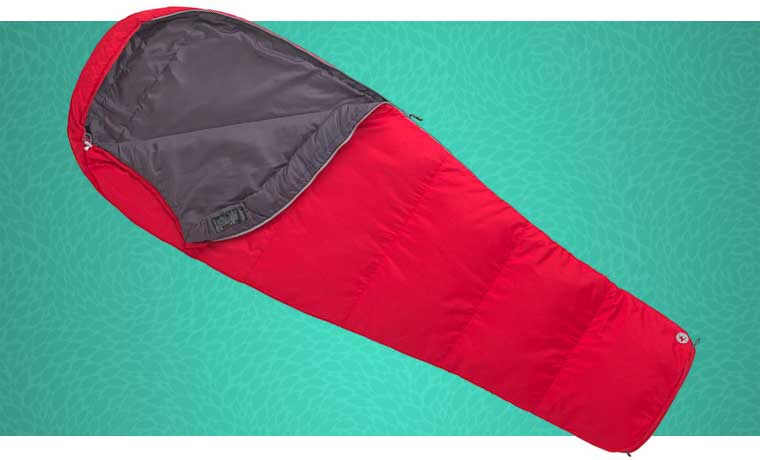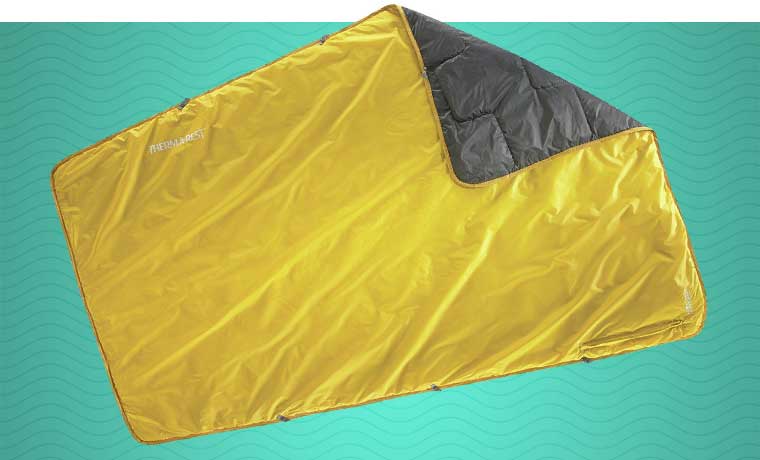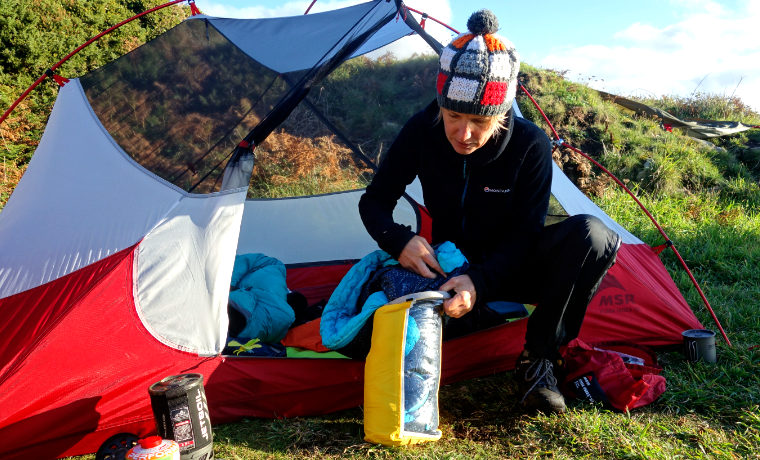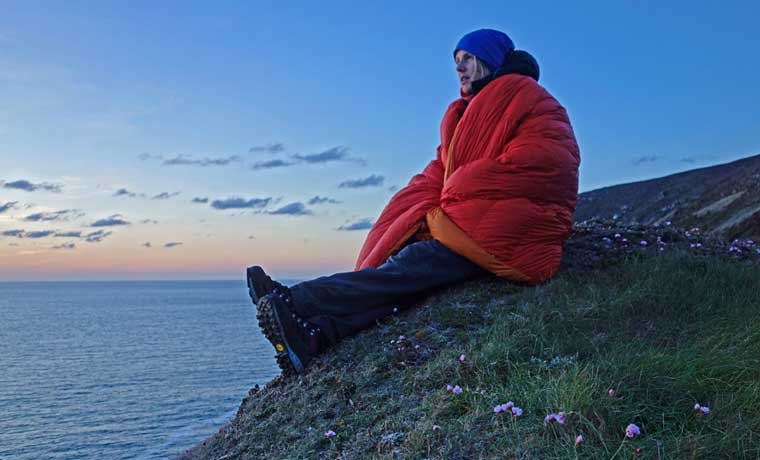Whatever adventure you’re on, few things are more important than a good night’s sleep. Sleep is restorative, and a night of tossing and turning will rob you of energy and affect your mood. Even your decision-making ability can be affected by sleep or a lack thereof.
The quality and duration of your sleep can hinge on your choice of equipment, which brings us nicely to the sleeping bags vs. quilts debate. Both have fans and detractors, and the right one for you is largely a matter of personal choice.
So, for this article, we’re going to compare and contrast sleeping bags vs. quilts so you can determine which one is best for you.
- Sleeping bags vs quilts: the basics
- Sleeping bag benefits and drawbacks
- Quilt benefits and drawbacks
- Camping quilt vs. sleeping bag: Which is best?
Sleeping bags vs quilts: the basics

Sleeping bag basics
Sleeping bags come in a variety of shapes and sizes. There are big, bulky rectangular bags that are ideal for car-trekking and static camping, and sleek “mummy” bags that weigh next to nothing, which are perfect for backpacking.
Some sleeping bags have synthetic fillings, while others are filled with feathers or down. Down bags tend to be lighter, warmer, and compress down into a small pack size. However, they can be expensive, require specialist cleaning, and don’t work well when wet.
In contrast, synthetic sleeping bags are usually bulkier and heavier but are easier to clean and considerably cheaper. They also retain more of their insulating properties if they get wet.
However, as sleeping bag material technology improves, synthetic bags are getting warmer and lighter, so down is no longer always the best filling option. For more information read our down vs synthetic article.
Regardless of the type we’re talking about, sleeping bags share some common characteristics. These include:
-
They fully envelop your body.
- Zips for easy access.
- Baffles to help keep out draughts.
- Shaped foot boxes for more comfortable feet.
- Often have hoods to trap heat inside the bag more effectively.

Quilt basics
You probably have a quilt on your bed at home. They used to be called continental quilts because, prior to the 1970s, most British people slept under piles of blankets! However, they’re now pretty standard in most homes.
Early continental quilts were also known as eiderdowns, as they were filled with down and feathers.
Nowadays, and mainly because of allergies associated with down, most quilts have a synthetic filling. Oh, and you probably call your quilt a duvet or comforter. Anyway…
Recently, lightweight quilts have become popular for backpacking and camping. However, unlike the quilt on your bed at home, most ultralight quilts pack down incredibly small, are reasonably weatherproof, and some even have enclosed foot boxes, so your lower body stays warm and toasty even if you toss and turn during the night.
There are down and synthetic quilts, although the down models tend to be lighter, pack down smaller, but also cost more.

Sleeping bag benefits and drawbacks
Not sure if a sleeping bag is the right option for you? Consider these pros and cons and then decide!
Sleeping bag benefits
-
Warmth
In the battle of the backpacking quilt vs. sleeping bag, sleeping bags have the potential to be warmer. They fully enclose your body, trapping warm air more effectively. Many have hoods, zip baffles, and shoulder drawstrings to keep out draughts and keep you even warmer.
Of course, the actual warmth of your sleeping bag depends on the type and thickness of the filling, which is why sleeping bags come with a temperature or season rating.
-
Easy to use
Let’s face it – even an outdoors neophyte should be able to figure out how to use a sleeping bag! Just unroll it and climb in. You’ll probably be able to manage this even in the dark.
-
Price and availability
While some sleeping bags are very expensive, you can buy a basic camping sleeping bag for under £50.00. All outdoor shops carry a wide range of sleeping bags, and you can also buy one from larger supermarkets and sporting goods stores.
Sleeping bag drawbacks
-
Weight
Because sleeping bags enclose you fully, they use a lot of material and filling. While some sleeping bags are incredibly light, this lightness normally comes at a cost – both in price and warmth. Things like zips, baffles, and drawstrings also add to the weight of your sleeping bag. All this extra weight can really add up, especially on a long trek.
-
Pack size
All that extra material means that sleeping bags can have a large pack size. That’s why some hikers go so far as to strap their sleeping bags to the outside of their rucksacks.
A good compression sack can help you squish your sleeping bag down smaller, but that also means you need to leave your bag to decompress for it to provide maximum insulation, which takes time.
-
Restrictive
A snug-fitting sleeping bag will trap more warm air but can feel restrictive, especially if you move around a lot at night or have a larger-than-average body size. Some sleeping bags are available in longer lengths, and a few allow you to add zip-in panels to increase the width, but this all adds to the weight.
-
Moisture and temperature control can be a problem
Sleeping bags can become damp if you get too warm during the night. You can undo the zip or pull the hood down, but then you may end up cooling down too fast and getting cold.
-
Not so versatile
Sleeping bags are for sleeping. You can’t really use one to stay warm while you’re sitting in front of your stove or taking a breather halfway up a snowy mountain trail.

Quilt benefits and drawbacks
Is a lightweight camping quilt the right choice for you? Weigh up these pros and cons and then decide!
Sleeping quilt benefits
-
Weight
Down and synthetic camping quilts tend to be lighter than the equivalent sleeping bag. They don’t have zips, baffles, etc., and are made with less material and insulating filling. While weights vary, the average ultralight backpacking quilt weighs 25% less than a similarly rated sleeping bag.
-
Smaller pack size
With less material, most camping quilts back down far smaller than a sleeping bag. This is useful if you are on an overnight trek and need to find space for the rest of your essential equipment.
-
Price
You can buy a good quality down or synthetic backpacking quilt for less than a similar quality sleeping bag. The materials and filling may be the same, but quilts are easier to make, so the price is usually lower. Down backpacking quilts are especially good value compared to the equivalent sleeping bag.
-
More freedom of movement
You can toss and turn as much as you like under your lightweight backpacking quilt without getting tangled in it. If you find sleeping bags leave you feeling a little claustrophobic, you’ll probably enjoy the freedom of movement that a lightweight quilt provides.
-
Use it anywhere and anytime
A quilt is basically a multipurpose lightweight backpacking blanket. You can sleep under it, drape it over your shoulders when you’re relaxing in front of a campfire, wrap yourself in it during your lunch of coffee break, or even wear it like a poncho when you’re doing your camp chores. Try doing any of that in your sleeping bag!
-
Work well with hammocks
Hammock camping is becoming increasingly popular, but getting into a sleeping bag in a hammock is a tough challenge for even seasoned hammock-ers. A quilt is much easier to use and means the risk of capsizing from your hammock is greatly reduced.
-
Sleep in your boots
Okay, this is a bit of a weird benefit, but there may be times when you need to sleep in your hiking boots. While the last thing you should do is wear your boots inside your camping sleeping bag, you can use a quilt without taking off your footwear.
-
Easier temperature regulation and less condensation
Because quilts aren’t so snug, air can circulate more freely, which prevents condensation. You can also regulate your temperature more easily simply by not wrapping yourself in it so tightly, great for camping in warmer conditions.
-
Better for bigger bodies
Even the largest body should fit comfortably under a synthetic or down camping quilt. Camping quilts are also available in different sizes. But, of course, the larger the quilt, the heavier it will be.
Sleeping quilt drawbacks
-
Not so warm
With no zips, foot box, or hood, you won’t be as warm under a quilt as you would with a sleeping bag. You may feel a draught as some of your body could be exposed. You may need to wear a hat and socks to keep your extremities warm.
Also, with no material beneath you, you’ll have to use your ultralight backpacking quilt with a sleeping mat. Some hikers forgo a sleeping mat to minimise weight, which is not really an issue with a sleeping bag, especially in warm, dry weather. However, most quilts aren’t big enough to cover you and provide something to lie on.
-
Sleeping under a quilt takes some getting used to
Sleeping under a camp quilt can feel a little weird at first, and you’ll need to find the best way to use your quilt to stay warm. This generally involves wrapping it around you and then tucking the edges underneath your feet, hips, and shoulders. There is no such learning curve with a sleeping bag.
Camping quilt vs. sleeping bag: Which is best?
In the battle of quilt vs. sleeping bag, there is no clear winner. The best option for you depends on your needs and preferences.
For example, if pack size and weight matter most, an ultralight quilt is arguably your best choice. But if you want to be as warm as possible, then a sleeping bag is probably the right option.
Want something that’s easy to use with no learning curve? Choose a sleeping bag. Want to wear your boots through the night or stay warm while cooking your dinner? Go for a quilt.
So, when deciding between a quilt or sleeping bag, consider how these functions and features affect you and go with whatever best meets your needs.
Sleeping bags vs. quilts – closing thoughts
Having tried sleeping bags and quilts, I must say I like the versatility of a quilt, especially for warmer weather. I also enjoy using my quilt when I’m not actually trying to sleep, such as during a rest stop on a mountain hike or just lounging in front of the TV at home.
However, you can’t beat a good sleeping bag when it comes to warmth. Yes, it’s a little heavier than my quilt and takes more space in my backpack, but you cannot beat the feeling of cocooning yourself in a sleeping bag. Cosy is the word!
The post Sleeping Bags Vs Quilts: Pros and Cons appeared first on Cool of the Wild.


